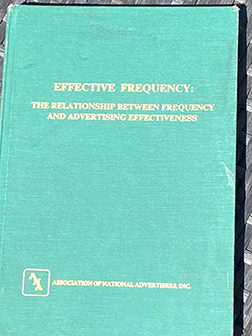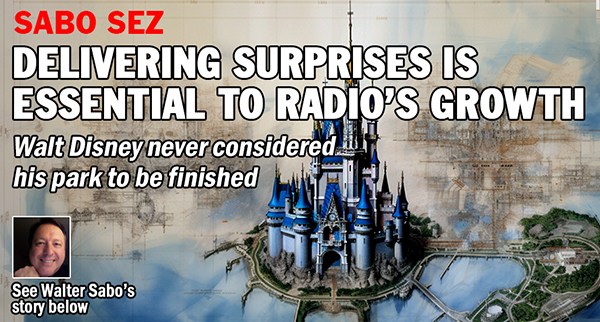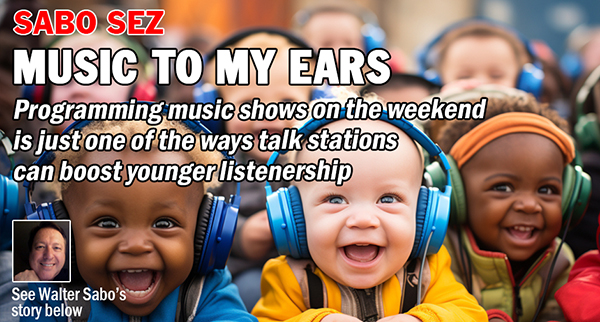Sabo Sez: Tap into The Book of Secrets
By Walter Sabo
Consultant, Sabo Media Partners
A.K.A. Walter M. Sterling
Radio Host, “Sterling On Sunday”
Talk Media Network
 Growing a brand is a memory game. Which message will a target consumer value, remember it and take it to the cash register? The answer is not complicated but it is complex.
Growing a brand is a memory game. Which message will a target consumer value, remember it and take it to the cash register? The answer is not complicated but it is complex.
A great amount of energy and brain power goes into brand names, logo design, show topics but very little study is made of how often a company should deliver information to their target. The answer to the question of “how often” is critical to landing marks in the Nielsen diary, seeking for your station online or in-car. Effective frequency is essential to everyone’s success!
“When you’re sick of the song, that’s when the listener is just hearing it…” is about all the science any of us have been tutored in on the subject of effective frequency.
about all the science any of us have been tutored in on the subject of effective frequency.
Frequency of message has, in fact, been studied for over 100 years and the answers are astonishing! The most important, useful frequency of message studies are in the book, Effective Frequency: The Relationship Between Frequency and Advertising Effectiveness.
I bought the book in 1981 to find answers to how much external advertising does a station need to win (remember?)… how often to rotate a song promo or topic? The answers are not found in myth and legends but in hard studies conducted by companies such as Lever Brothers and Procter & Gamble.
The book was assembled by the Association of National Advertisers. It is a collection of landmark major studies on how memory is Impacted by the frequency of message exposure. Expertise on the workings of memory is obviously the most important knowledge in a Nielsen diary market and vital to growth in metered markets if a station has been starved of a promotion budget. This book was edited by the head of research for Lever Brothers, Michael J. Naples.
The next three Sabo Sez columns will highlight more actionable data from the book. For example, the studies in the book offer hard data about on how many spots your listener can tolerate, how often to state and restate the topic, phone number, your name and more. This book has, by far, offered my work the most powerful guidance of any source.
Here are a few facts you might be able to put to use right now:
1. The first and last spot in a cluster enjoys the greatest recall. Promos work equally well in either position. Spots placed first and last should be charged more.
2. Moving money out of a TV campaign and putting it into a radio campaign will neither diminish nor improve response. BUT holding the money in a TV campaign and adding money for a radio campaign will improve response.
3. Stunning: For many product categories, daypart significantly impacts the likelihood of conversion to sales. Food product commercials, according to an Ogilvy & Mather study, convert to sales significantly better in late night, fringe time than in daytime. In fact, food product ads in prime time have a negative impact on sales.
4. Properly conducted research for consumer goods products can be successfully applied to media content development.
Walter Sabo has been a C Suite action partner for companies such as SiriusXM, Hearst, Press Broadcasting, Gannett, RKO General and many other leading media outlets. His company HITVIEWS, in 2007, was the first to identify and monetize video influencers. HITVIEWS clients included Pepsi, FOX TV, Timberland, Microsoft, and CBS Television. He can be reached at walter@sabomedia.com and www.waltersterlingshow.com. “Sterling On Sunday,” from Talk Media Network airs 10:00 pm-1:00 ET, now in its 10th year of success.



 It seems every hour Nielsen and Pierre Bouvard of Cumulus fame (formerly of Westwood One) put out a release stating that radio is just fine, thank you. Radio is more persuasive than TV, direct mail, streaming and print. Radio is a proven success for over 100 years. Most of the buildings housing Procter & Gamble were built on radio – not TV – advertising success. Happily, P&G realized radio’s clout and is now a dominant radio advertiser – again!
It seems every hour Nielsen and Pierre Bouvard of Cumulus fame (formerly of Westwood One) put out a release stating that radio is just fine, thank you. Radio is more persuasive than TV, direct mail, streaming and print. Radio is a proven success for over 100 years. Most of the buildings housing Procter & Gamble were built on radio – not TV – advertising success. Happily, P&G realized radio’s clout and is now a dominant radio advertiser – again! 1. Financial solvency laws. Consolidation is not the problem; it actually saved the radio industry. The problem is the 1986 rule change that dropped financial solvency requirements for station ownership. Prior to 1986, stations could not be purchased with debt. A potential owner had to prove that they could meet the expenses of a station through the duration of its license. Once the financial efficacy rule was dropped and stations could be purchased with debt, the industry was financially decimated. Prediction: Financial solvency laws will be re-instated.
1. Financial solvency laws. Consolidation is not the problem; it actually saved the radio industry. The problem is the 1986 rule change that dropped financial solvency requirements for station ownership. Prior to 1986, stations could not be purchased with debt. A potential owner had to prove that they could meet the expenses of a station through the duration of its license. Once the financial efficacy rule was dropped and stations could be purchased with debt, the industry was financially decimated. Prediction: Financial solvency laws will be re-instated. Original ideas are golden and rare. Here are five ideas worth stealing because of their novelty, success and oh-wow factor!
Original ideas are golden and rare. Here are five ideas worth stealing because of their novelty, success and oh-wow factor! When reviewing our industry’s awards such as the Crystals or Marconis there are two categories missing. They are: “Best New” and “Best Innovation.” Imagine if winners were announced for these prizes:
When reviewing our industry’s awards such as the Crystals or Marconis there are two categories missing. They are: “Best New” and “Best Innovation.” Imagine if winners were announced for these prizes: For several years I’ve had the surprising privilege of serving as a member of the nominating committee of the Radio Hall of Fame. How does the process work? Let me clear up some of the mystery. FAQ:
For several years I’ve had the surprising privilege of serving as a member of the nominating committee of the Radio Hall of Fame. How does the process work? Let me clear up some of the mystery. FAQ: NO ONE has done more to elevate the status and improve the working conditions of on-air talent as much as Howard Stern.
NO ONE has done more to elevate the status and improve the working conditions of on-air talent as much as Howard Stern. Acknowledging that this publication is fiercely non-partisan and that I – in my role as a broadcaster – am basically the same, I offer the following, not as a political opinion piece, but rather a personal observation based on experience that might shed light on the deeper nature of a large segment of the American population prone to listen to talk radio.
Acknowledging that this publication is fiercely non-partisan and that I – in my role as a broadcaster – am basically the same, I offer the following, not as a political opinion piece, but rather a personal observation based on experience that might shed light on the deeper nature of a large segment of the American population prone to listen to talk radio. Sears used to sell everything. Tractors, tires, insurance, investments, chickens. In 2004, Sears was the dominant retailer in America. By the end of the decade, it was feverishly closing stores and dying.
Sears used to sell everything. Tractors, tires, insurance, investments, chickens. In 2004, Sears was the dominant retailer in America. By the end of the decade, it was feverishly closing stores and dying. Research shows that readers to trade publications like articles with five bullet points. Here are my five bullet points for 2024. If these were to be deployed, you could be thriving by the end of the year. These actions would increase sales and audience share.
Research shows that readers to trade publications like articles with five bullet points. Here are my five bullet points for 2024. If these were to be deployed, you could be thriving by the end of the year. These actions would increase sales and audience share. WHAT WOULD YOU DO? A very good major market DJ murders his wife and injures her lover upon catching them in the marital bed. An 11-year-old girl was in the house – a witness. The murderer is convicted (second-degree murder/“situational crime”) sent to prison, does his time and is released after a few years for good behavior while incarcerated.
WHAT WOULD YOU DO? A very good major market DJ murders his wife and injures her lover upon catching them in the marital bed. An 11-year-old girl was in the house – a witness. The murderer is convicted (second-degree murder/“situational crime”) sent to prison, does his time and is released after a few years for good behavior while incarcerated. Earlier this week, Michael Harrison published his top 10 list of suggestions for being a successful talker. Item number three really caught my eye:
Earlier this week, Michael Harrison published his top 10 list of suggestions for being a successful talker. Item number three really caught my eye:
 In May 2007, I was enjoying the brand-new app called YouTube. Still independently owned, still relatively unknown. Some of the videos pulled millions of viewers, more viewers than enjoyed by ESPN or any cable network. More interesting, the videos with high counts were not made by NBC or ESPN or any traditional video source. High view count videos were being made by people with no experience in traditional media, they were experimenters producing in their basements and bedrooms.
In May 2007, I was enjoying the brand-new app called YouTube. Still independently owned, still relatively unknown. Some of the videos pulled millions of viewers, more viewers than enjoyed by ESPN or any cable network. More interesting, the videos with high counts were not made by NBC or ESPN or any traditional video source. High view count videos were being made by people with no experience in traditional media, they were experimenters producing in their basements and bedrooms. As your friends get fired and on-air hosts are replaced with WideOrbit and Profitable Software, the mournful refrain is to unfairly blame consolidation. Consolidation has, in fact, made the medium financially viable and brought hundreds of individual stations from a river of red ink to the glow of black ink. Prior to consolidation, over half the radio stations in the U.S. lost money – year after year. Not a secret stat, those numbers were revealed annually by the NAB.
As your friends get fired and on-air hosts are replaced with WideOrbit and Profitable Software, the mournful refrain is to unfairly blame consolidation. Consolidation has, in fact, made the medium financially viable and brought hundreds of individual stations from a river of red ink to the glow of black ink. Prior to consolidation, over half the radio stations in the U.S. lost money – year after year. Not a secret stat, those numbers were revealed annually by the NAB.
 The persistent liability of most talk stations is that they attract a high percentage of listeners over the age of 65. Consider that many of those older listeners are attracted to radio shows that are talking for companionship and comfort.
The persistent liability of most talk stations is that they attract a high percentage of listeners over the age of 65. Consider that many of those older listeners are attracted to radio shows that are talking for companionship and comfort.
 Dependency upon a PPM panel to deliver high time spent listening is a bad business model. Would you rather count on one person listening for one hour or four people listening for 15 minutes? Right.
Dependency upon a PPM panel to deliver high time spent listening is a bad business model. Would you rather count on one person listening for one hour or four people listening for 15 minutes? Right. For decades the power-lunch spot in Manhattan was the beautiful Four Seasons restaurant. Check it out:
For decades the power-lunch spot in Manhattan was the beautiful Four Seasons restaurant. Check it out: